It's a tie
Life-changing superheros
Unlike any other comparison, this GetResponse vs Mailchimp comparison ends in a tie. However, these platforms have their own different strengths and weaknesses. Carry on reading to figure them out.
Mailchimp has earned a reputation for its user-friendly interface and creative design options, attracting diverse users, including startups and small businesses.
GetResponse, on the other hand, is renowned for its powerful marketing automation capabilities, making it a popular choice among businesses seeking to streamline their email campaigns.
So, how do these tools compare?
GetResponse vs Mailchimp: Quick overview
Mailchimp has a positive rating of 3.6 on the Shopify app store, meaning it’s an efficient choice for ecommerce businesses.
GetResponse has a lower rating of 1.5 on the Shopify app store, which raises concerns about its compatibility and performance within Shopify.
This suggests that GetResponse might have some limitations when working smoothly with the Shopify platform.
So, is GetResponse still a powerful email marketing platform?
Yes. We found that the tool offers 200 modern-looking email templates. This can be a significant advantage for users who value creative and visually appealing communication with their audience.
But is it better than Mailchimp?
That’s what we’ll discover in this detailed review of GetResponse vs Mailchimp.
Both tools have similar features. But when we look closer, we’ll find out what sets GetResponse apart from Mailchimp.
Let’s explore the details further.
GetResponse vs Mailchimp comparison: Feature by feature
In this section, we’ll closely examine various aspects of both platforms, including:
- Ease of getting started
- Building an email campaign
- Marketing automation
- Signup forms and landing pages
- Segmentation
- Analytics
- Customer support
- Integrations
- Compatibility with other marketing tools
At the end of each feature section, we’ll declare a winner to simplify your decision-making process.
Let’s dive right in.
Ease of getting started
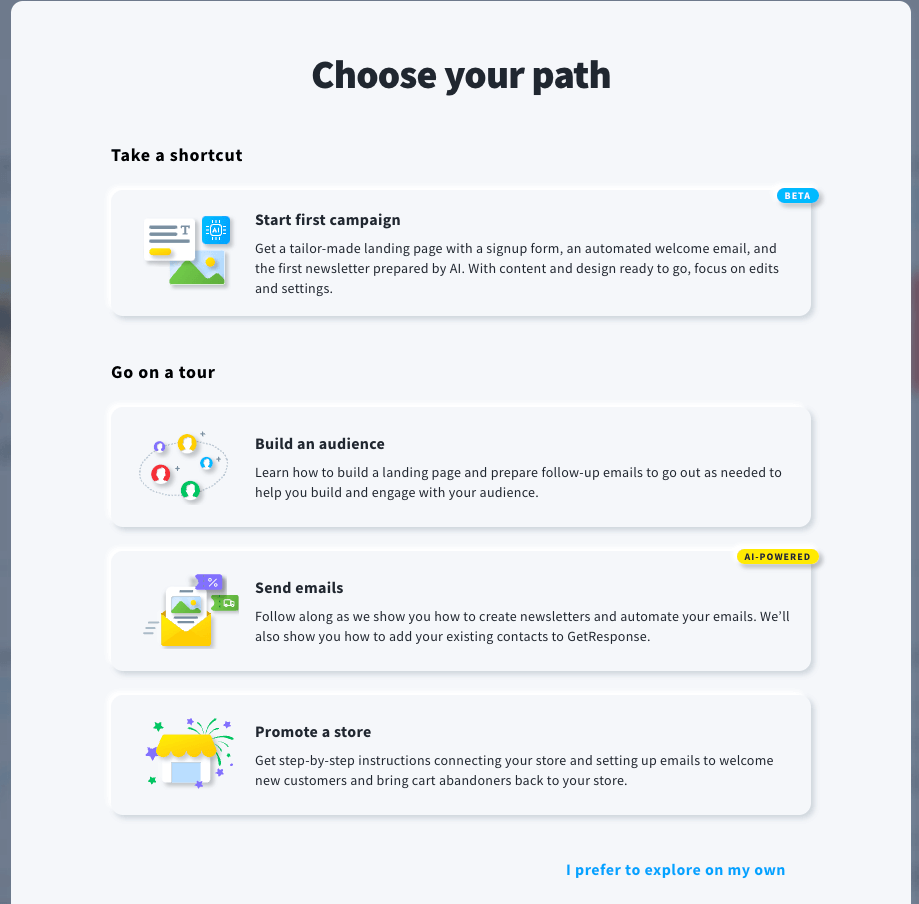
How easy is it to sign up on GetResponse and Mailchimp?
Well, both platforms offer relatively straightforward onboarding processes, but with some notable differences.
GetResponse provides hassle-free signup without requiring a credit card. Users can easily create an account and access the necessary settings.
On the other hand, Mailchimp offers an easy signup process, but it requires a credit card for a free 30-day trial.
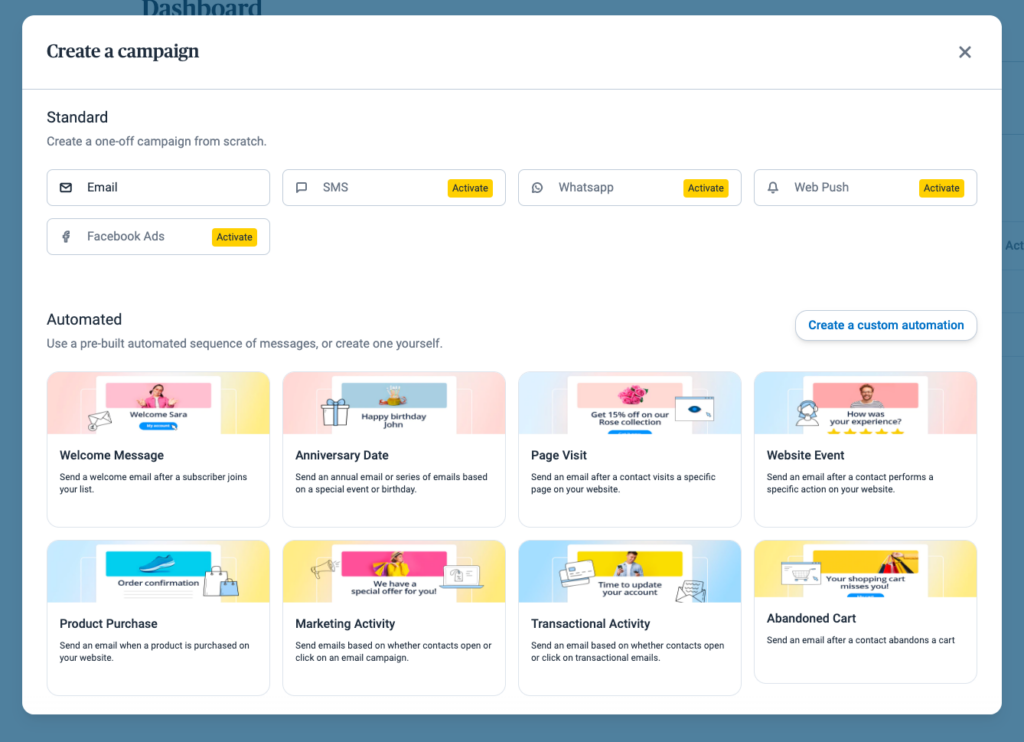
This platform has an extended functionality and we found it challenging to discover certain features immediately.
The good thing is Mailchimp offers a helpful checklist to guide beginners in setting up their accounts, which adds to the overall user onsite experience.
Regarding GetResponse, we found that the platform’s interface and navigation are well-thought-out, with precise menu logic. We didn’t encounter any difficulties when trying to locate and modify settings.
So which one wins?
GetResponse wins this round. Both platforms are easy to use. However, GetResponse makes all necessary settings easy to find and modify. Plus, you don’t need a credit card to sign up.
Building an email campaign
Both GetResponse and Mailchimp impress with their intuitive and straightforward email campaign wizards. But they have other unique features that set them apart.
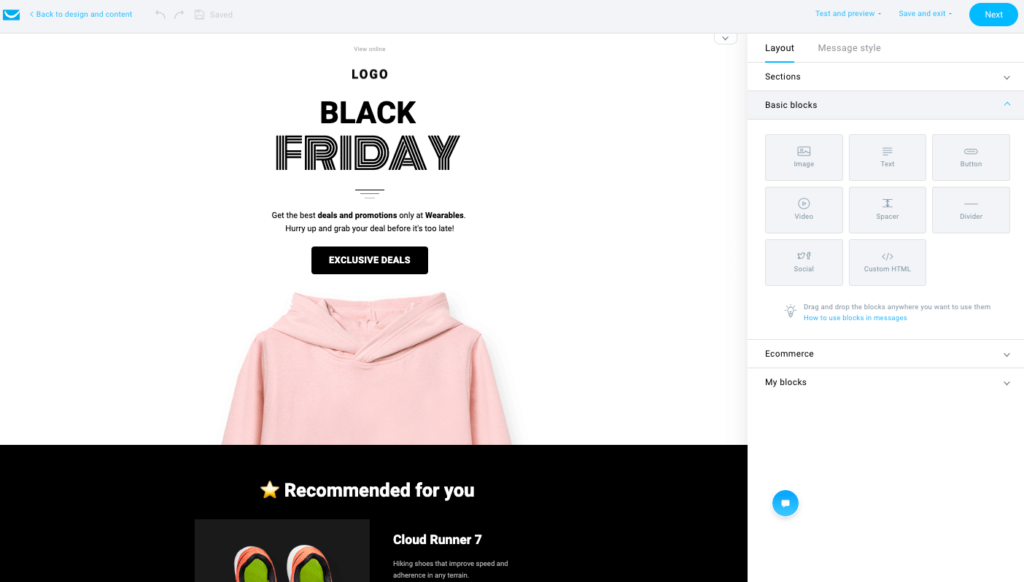
GetResponse’s editor is well thought out and organized, providing all the basic content elements. It offers useful ecommerce content blocks like the product element for pulling products with prices and descriptions from your store.
The best part?
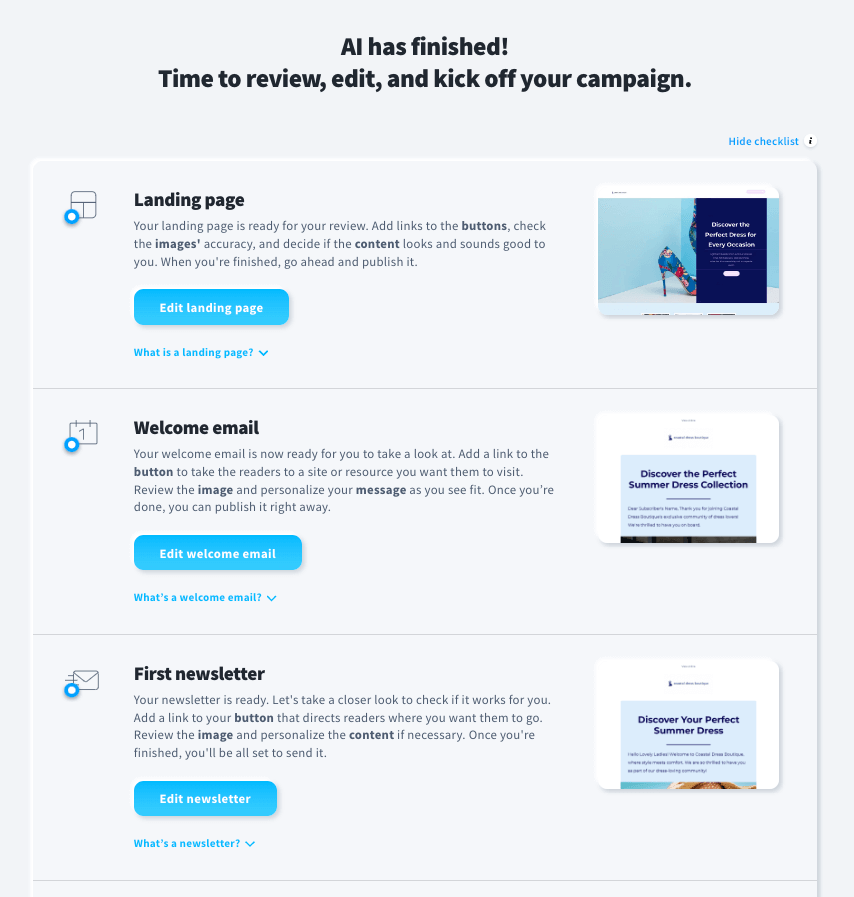
Recently, GetResponse has launched its AI-generated campaigns. Its product recommendation element and coupon codes empower significant email personalization. Plus, 200+ modern email templates help users send professional and compelling email campaigns.
Mailchimp, on the other hand, offers an updated email builder with many valuable features and with great user experience.
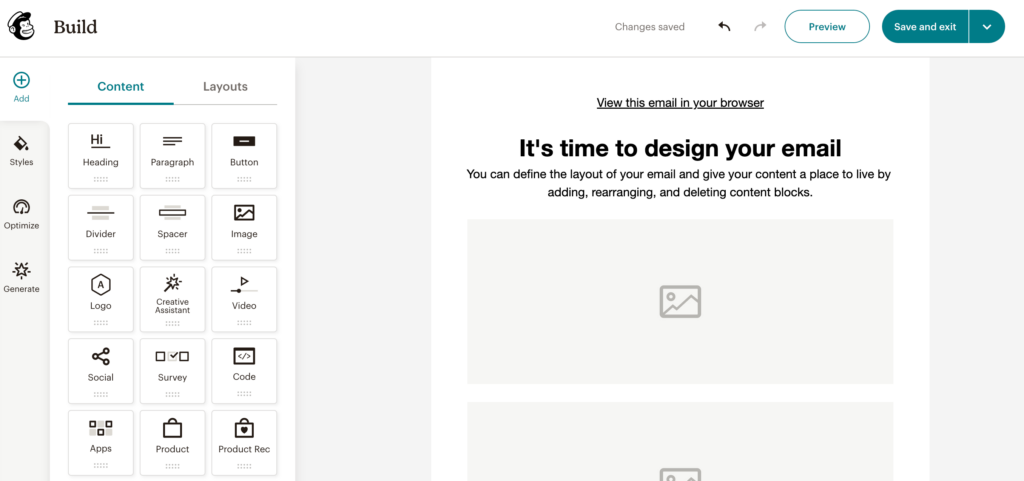
Regarding email templates, Mailchimp’s free plan offers only six basic layouts. You’ll need to upgrade to a paid plan to access good-looking and modern email templates.
In addition, Mailchimp offers dynamic content blocks, postcard campaigns, surveys, and subject line recommendations.
The integration with Litmus offers 25 tokens of inbox preview on different devices, adding to the platform’s versatility.
However, removing the Mailchimp tag from the email footer is quite challenging. Also, you can schedule an email campaign only if you have a paid plan.
Within GetResponse, elements like image carousels and surveys are missing from the builder. Also, ecommerce tracking is only available in the highest-tier plans.
So, which one do you think has the best email campaign builder?
It’s a tie in this round. Both tools have their limitations but shine in their user-friendly, top-notch email editors.
Marketing automation
Which tool provides more comprehensive marketing automation capabilities?
There is no single answer to this question. Let’s take a closer look at each offering.

GetResponse users can take multiple actions, such as setting up logic splits, adding dynamic segments, and scoring leads.
Also, it offers a wide array of conditions and tags, allowing for automation based on the following:
- Customer behaviors
- Onsite activities
- Purchases
- Email engagement
- Personal details
GetResponse provides 43 pre-built automation workflows tailored to common ecommerce scenarios, like welcome, post-purchase, sales promotions, etc. So users can easily set up automated processes and launch automated campaigns in minutes.
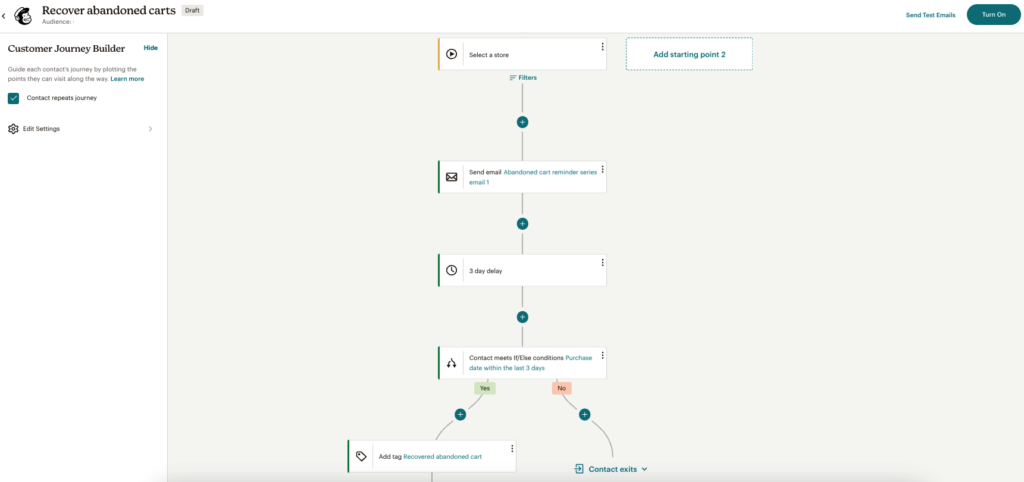
Meanwhile, the Mailchimp automation part also looks sufficient. This platform offers a user-friendly automation interface with an editor similar to other tools.
It also offers over 70 pre-built customer journey workflows that incorporate various marketing channels beyond emails. Of course, to achieve this, you will likely need additional integrations with third-party tools like Slack, Twilio, etc.
On the flip side, GetResponse has built-in web push notifications and integrated SMS marketing. But it’s worth noting that some advanced features, including SMS, product recommendations and abandoned cart triggers, are only available in the highest-tier plans. We hoped for more in the entry-level plans.
GetResponse offers more robust marketing automation functionality, more built-in channels and overall better marketing automation experience.
Signup forms and landing pages
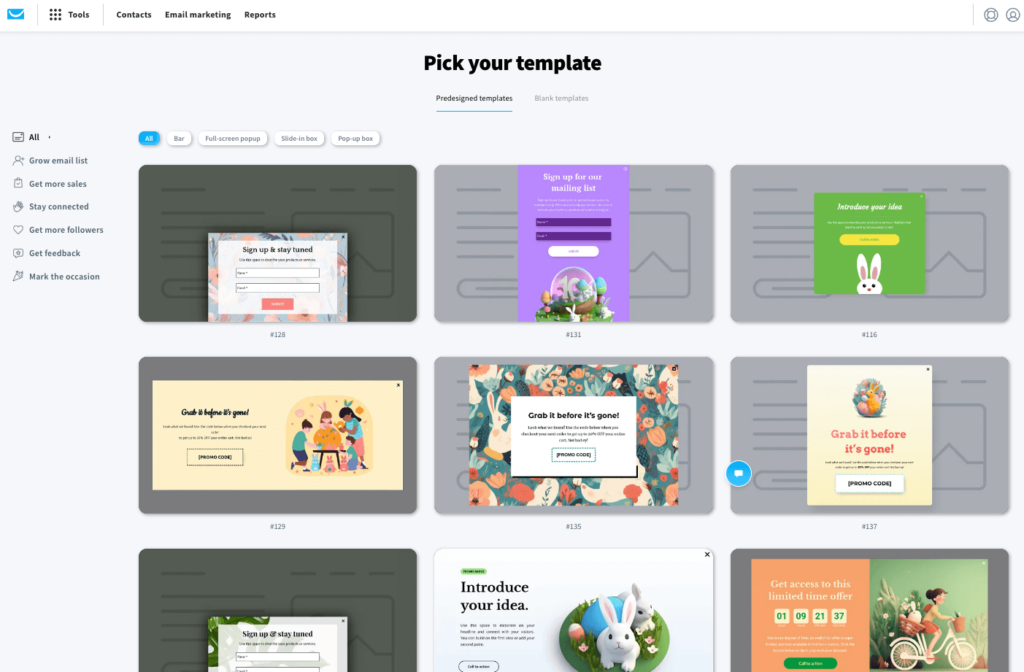
GetResponse offers 150+ modern-looking signup forms to choose from. The prebuilt signup forms can be displayed as popups or embedded forms on a page.
Even better, the tool provides analytics to track the performance of signup forms, offering insights on views, clicks, CTR, and leads, allowing you to optimize campaigns effectively.
In contrast, Mailchimp takes a different approach to signup forms. You’ll discover a signup form builder with a single layout and need to construct your signup form from scratch. While the signup form builder is user-friendly, Mailchimp lacks the extensive library of beautiful, ready-to-use templates that GetResponse offers.
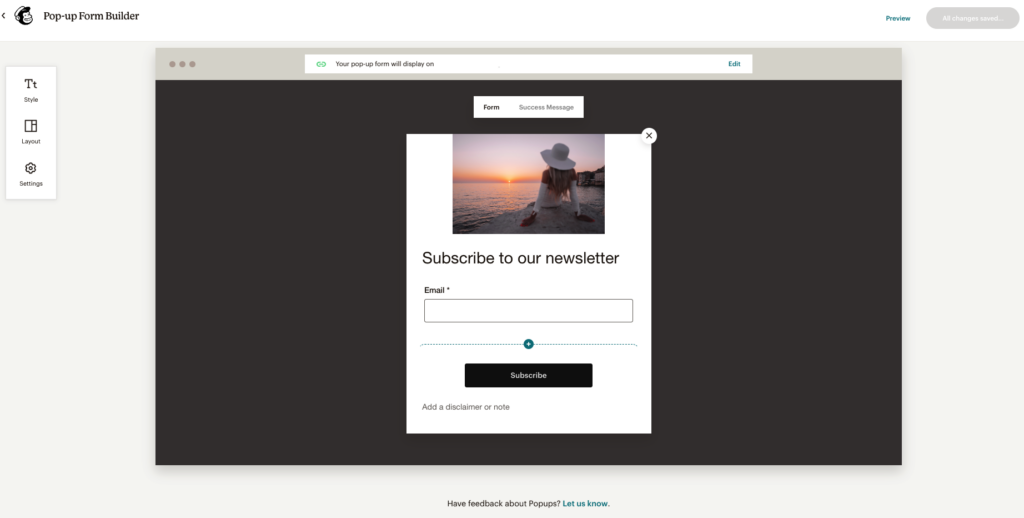
Mailchimp’s landing page feature is noteworthy, offering nine templates and a strong landing page builder that competes with some of the best in the market.
Meanwhile, GetResponse also boasts a robust landing page feature with a drag-and-drop editor. It offers customization options without requiring coding skills and many excellent designs and templates for various purposes like growing the list, selling products via funnels, promoting webinars, or telling people about your company.
One of the biggest drawbacks of Mailchimp that is worth mentioning is the method of how they count subscribers. On Mailchimp, all lists are siloed, so you will have to pay for repeating subscribers on different lists. That’s not an economical approach.
GetResponse outperforms its competitor with an extensive library of signup forms, a robust landing page builder, and budget-friendly contact list management.
Segmentation
Which tool has the best segmentation capabilities? GetResponse or Mailchimp?
That’s what we’ll cover in this section.
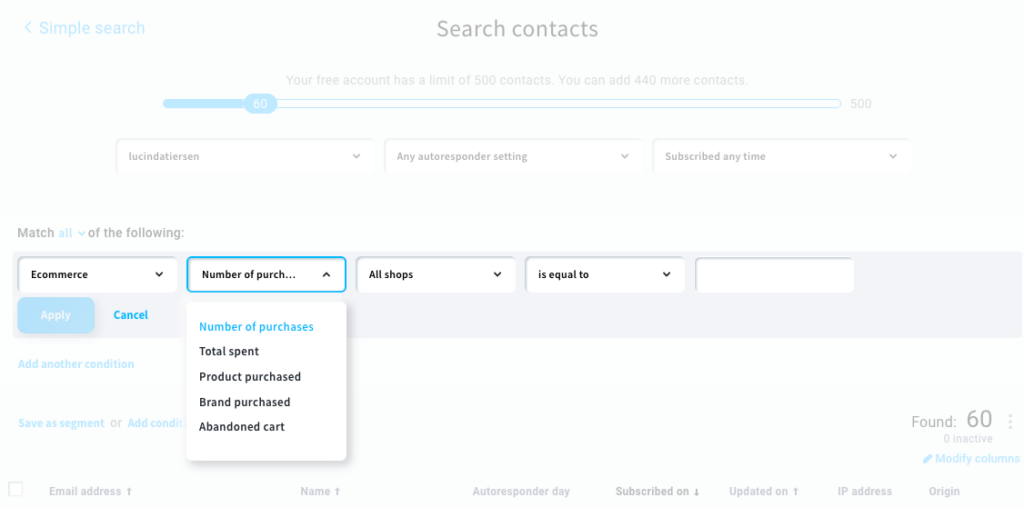
GetResponse doesn’t provide ready-to-go audiences. You’ll be required to set up their segments from scratch. Yet, segmentation is very robust on GetResponse, offering a wide range of criteria for segmenting the audience.
You can segment contacts based on parameters such as contact details, contact actions, geolocation, scoring, tags, consent fields, ecommerce behavior, conversion funnel, events, and lead magnets. However, we couldn’t find any onsite behavior criteria among the options.
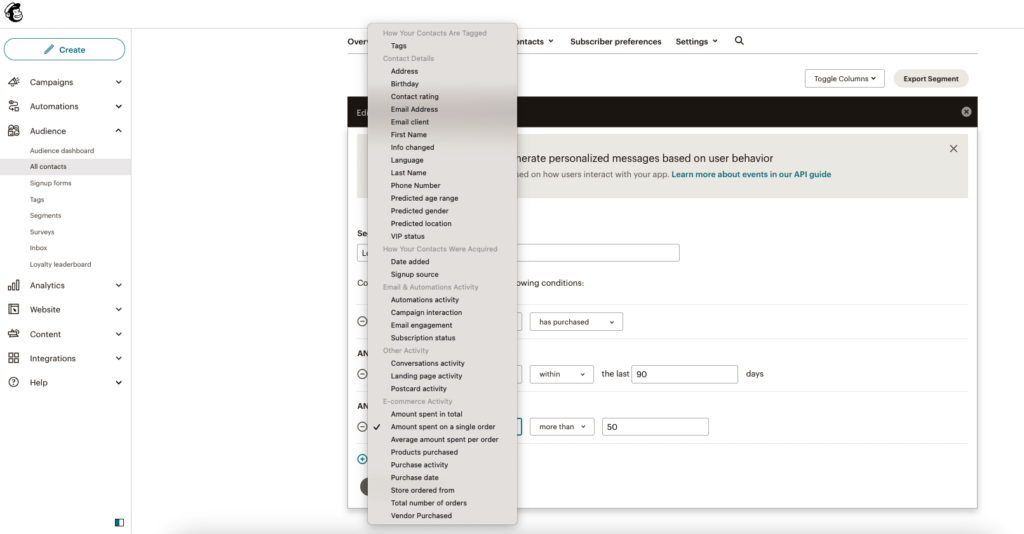
On the other hand, Mailchimp offers ready-to-go audiences, though the number of pre-built segments is limited to three. However, the platform’s segmentation features look sufficient.
It allows you to include five conditions on each segment, which can be sufficient for most cases. However, you may require more options for complex segmentation strategies. And this can be a significant drawback.
Both platforms offer very good segmentation, but Mailchimp takes the lead in this round for its prebuilt segments, which can significantly help beginners.
Analytics
GetResponse and Mailchimp both provide you with detailed analytics on your campaigns.
GetResponse provides comprehensive analytics with a report for almost everything you want to track. You can gain valuable insights into your email campaigns and audience management.
However, the downside is that ecommerce reports are only available on the highest-tier plans. This limitation might be a drawback for businesses looking for in-depth insights into their ecommerce activities.
Similarly, Mailchimp provides an extensive array of analytics, but it falls short of depth in ecommerce metrics. Some of the things you can track include:
- Standard opens and clicks
- Social media engagement
- Landing page engagement rate
- Campaign forwarding and opens
- Conversion metrics
Also, you can get valuable insights through comparative reports, allowing you to analyze different campaigns’ performances. Sadly, the comparative reports are only available for Premium plan users.
Mailchimp wins this round. While they both offer comprehensive analytics, Mailchimp offers more insights on the entry-level plans and comparative reports.
Customer support
GetResponse offers email and chat support 24/7 to users. It’s worth noting that phone support is available exclusively to the highest-tier plan users.
On the downside, free plan users don’t receive any support. This may not favor you if you’re on a limited budget.
Despite that, free plan users can use many resources and tutorials, including video tutorials, to solve their problems. This can help you quickly navigate and maximize the platform’s functionalities.
In contrast, Mailchimp’s customer support varies based on the plan chosen. Free users have access to email support for the first 30 days.
Paid customers enjoy 24/7 email and chat support. What’s more, Premium plan users get the additional benefit of priority support and the ability to call for assistance.
Mailchimp’s live chat support quickly connected with a human assistant within a few minutes when we tried it out.
Additionally, Mailchimp offers many useful resources, which include:
- Mailchimp 101 tutorial
- Blog articles
- Resources grouped by channels, business stages, and interests
- Educational videos on YouTube in different languages
Mailchimp takes the lead. It offers better customer support across plans.
Integrations
Mailchimp offers 300+ integrations with a diverse range of tools. You can effortlessly connect your preferred apps and web services, including WordPress, Shopify, and Canva with it. This seamless integration empowers you to maximize productivity and achieve more in less time.
GetResponse also boasts a wide range of integrations. It provides integrations with the most widely used platforms across industries. However, most of these are through Zapier.
This ensures you have access to a diverse range of solutions to meet your unique requirements.
Mailchimp wins this round. It offers a broader variety of native integrations, which makes it a great choice.
Compatibility with other marketing channels
It’s important to check the compatibility of an email marketing tool with other marketing channels.
Both Mailchimp and GetResonse work with other marketing tools.
GetResponse supports SMS marketing, push notifications, Facebook Pixel, Google Ads, and Facebook Ads.
This makes it a versatile platform that connects seamlessly with different marketing channels. On the downside, SMS marketing is only available for users on the MAX plan. This may be a limitation for those on lower-tier plans.
Mailchimp provides integrations with several marketing channels, including SMS, Facebook, Instagram, and Google Analytics too.
However, it lacks direct support for push notifications. This is a drawback if you are seeking such functionality.
It’s a tie. Both platforms offer an extended list of other marketing channels.
Price Comparison
Pricing often plays a crucial role in selecting the ideal email marketing software.
As we conclude this GetResponse vs. Mailchimp comparison, we’ll delve into their free and paid plans, thoroughly evaluating both the cost and the features provided.
So, which software is more budget-friendly? Mailchimp or GetResponse?
Let’s find out.
Free plans comparison
Mailchimp does offer a free plan, but it’s quite limited and marketers looking for ecommerce features must opt for a paid plan to access these features.
Likewise, GetResponse offers a free plan, but the lack of customer support and features puts it at a disadvantage.
Let’s compare what you can get for free on both tools.
Here’s a side-by-side view of what you can get for free with both tools.
Paid plans comparison
GetResponse offers three pricing plans, and they are:
- Email marketing
- Marketing automation
- Ecommerce marketing
Likewise, Mailchimp offers three pricing plans which are Essentials, Standard, and Premium.
Here’s a side-by-side comparison of paid plans for GetResponse and Mailchimp with monthly pricing.
As you can see, GetResponse offers the most budget-friendly prices, making it an appealing choice for businesses conscious of their budget.
Also, it offers two plans, Max and Max2, for enterprises, and they have custom pricing.
GetResponse provides notably tailored plans at reasonable costs, making it a suitable option for small and mid-sized ecommerce businesses.
On the other hand, Mailchimp stands out by providing additional capabilities for just a small price difference, making the investment worthwhile for those seeking enhanced functionalities.
The added features offered by Mailchimp, such as behavioral targeting, customer lifetime value insights, direct integration with Shopify, user seats, a website builder, SEO tools, and a free Mailchimp domain, justify its slightly higher cost.
These features can significantly enhance the overall marketing experience and provide a competitive edge.
Summary - Which one wins?
Before we decide whether Mailchimp or GetResponse wins, here’s a summary of the features and pricing of GetResponse and Mailchimp.
4.5
4.6
Free plan — Yes
For Essentials plan:
500 subscribers — $13
1,000 subscribers – $27
5,000 subscribers — $75
10,000 subscribers —$110
50,000 subscribers — $385
100,000 subscribers — Not available on this plan
Free plan — Yes
For Email Marketing plan
500 subscribers – $0
1,000 subscribers – $19
5,000 subscribers – $54
10,000 subscribers – $79
50,000 subscribers – $299
100,000 subscribers – $539
- 500 contacts
- 1000 email sends per month
- Email support for first 30 days
- 300+ integrations
- Forms and landing pages
- Limited reporting and analytics
- 500 contacts
- 2500 email sends per month
- Signup forms
- Basic email tracking
- All email templates
- Basic segmentation
- Has a very wide range of features
- Has a wide variety of integrations
- Easy to use
- Complete tool with lots of features
- Affordable price
- Easy to use
- Mailchimp charges for email duplicates
- Very limited free plan
- Paid plans get expensive quickly
- Email templates on free plan are too basic for current ecommerce needs
- Might be a bit overwhelming for beginners
- Ecommerce features available in the highest-tier plans only
- Small ecommerce businesses
- Solopreneurs
- Start ups
- Bloggers
- Non profit organizations
- Small and mid-size ecommerce businesses
- Ecommerce stores that are in their active growth stage
- Complete email marketing beginners
- Solopreneurs
- Non profit organizations
- Bloggers
GetResponse is undeniably a great tool in its own right, offering a variety of features at affordable prices.
Its user-friendly interface and robust email-building wizard make it an attractive option for businesses of all sizes.
On the other hand, Mailchimp shines with its advanced capabilities, catering to a diverse range of marketing needs.
Its extensive range of analytics, comparative reports, and numerous integrations provide a comprehensive solution for users looking to elevate their email marketing efforts.
Ultimately, the choice between GetResponse and Mailchimp depends on your specific requirements and preferences.
Read full reviews
Related picks for you
Our team strives to be accurate and unbiased in reviewing email tools. However, we recognize that mistakes can happen, and it’s essential for us to stay up to date. If you come across any errors or things that need to be reviewed again, please let us know.





Leave a Reply